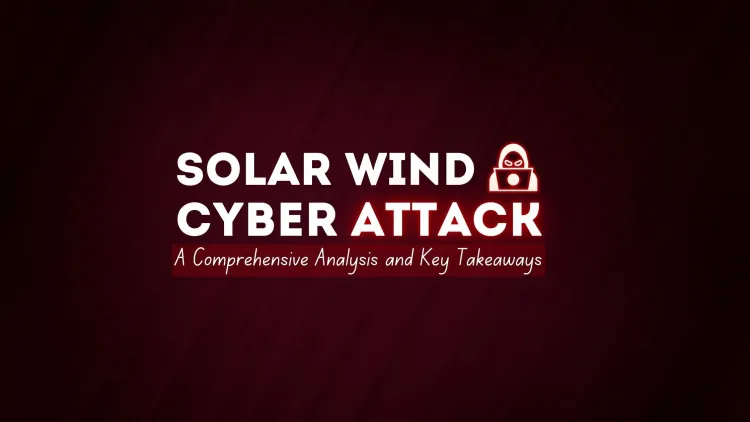What is SolarWinds Attack ? Details You Need To Know About It
The SolarWinds cyberattack of 2020 was one of the most sophisticated and damaging cyberattacks in recent history, targeting a trusted IT management software provider. Hackers infiltrated SolarWinds' systems, inserting malicious code into updates of their Orion platform, which were then distributed to thousands of organizations globally. This supply chain attack affected major government agencies, private corporations, and critical infrastructure providers. The attackers gained long-term, stealthy access to sensitive data and systems, making it difficult to detect the breach for months. The attack highlighted several key cybersecurity lessons, including the importance of supply chain security, multi-layered defense systems, and early detection. It also underscored the need for regular software updates and strong collaboration between organizations to respond to cyber threats. To protect against similar attacks, organizations are advised to strengthen their supply chain security, implem

In December 2020, one of the largest and most sophisticated cyberattacks in recent history was discovered. It targeted SolarWinds, a company that provides network management and monitoring software. The attack was highly advanced and affected government agencies, private companies, and other organizations across the world. In this blog, we’ll break down what happened during the SolarWinds cyberattack, how it worked, and what we can learn from it.
What is SolarWinds?
SolarWinds is a company based in the United States that offers software solutions for IT management. Their tools are used by organizations to monitor and manage their networks, servers, applications, and other critical IT systems. SolarWinds’ software, especially their Orion platform, is trusted by many large organizations, including government agencies and big corporations, to ensure that their IT infrastructure is running smoothly.
Key SolarWinds Products:
- Orion Platform: Used for monitoring and managing network performance and infrastructure.
- Network Performance Monitor: Tracks and monitors network health.
- Server & Application Monitor: Keeps an eye on servers and applications to ensure they run properly.
The SolarWinds Cyberattack: What Happened?
The SolarWinds cyberattack was a supply chain attack, which means the hackers targeted SolarWinds' software to reach its customers, rather than attacking the customers directly. Here’s how it unfolded:
1. Infiltration:
The hackers first gained access to SolarWinds’ systems and compromised its software development process. They inserted a backdoor (malicious code) into an update for the Orion platform. This update was then sent to SolarWinds' customers, who trusted the company’s software updates.
2. Malicious Update:
The attackers made sure that the update, which appeared to be legitimate, was installed by customers around the world. Once the update was installed on customers’ systems, the malicious code was activated, allowing hackers to access sensitive data and systems.
3. Stealthy Access:
Once the malicious code was in place, the hackers could quietly spy on their victims. They had access to the networks and data of thousands of organizations, but they moved very carefully to avoid detection. This allowed them to gather valuable information without triggering any alarms.
4. Exploitation:
After gaining access, the attackers could use the backdoor to further infiltrate the systems. They looked for sensitive data, like passwords, emails, and other confidential information. In some cases, they also tried to steal intellectual property or cause damage to systems.
5. Impact:
The attack affected over 18,000 organizations worldwide. Some of the most notable victims were:
- U.S. government agencies like the Department of Homeland Security and the Department of Energy.
- Private companies like Microsoft, Intel, and Cisco.
- Critical infrastructure providers in industries like energy and healthcare.
Why Was This Attack So Dangerous?
The SolarWinds cyberattack was particularly dangerous for several reasons:
1. It Targeted Trusted Software:
Because SolarWinds’ software was widely trusted, many organizations didn’t hesitate to install the update. This gave the attackers easy access to a large number of systems, including some of the most sensitive ones.
2. It Was Stealthy:
The attackers were careful not to trigger alarms. They used sophisticated techniques to hide their actions, making it very difficult for security teams to detect the breach for a long time.
3. It Affected Governments and Large Corporations:
The attack wasn’t just aimed at small businesses; it impacted major government agencies and large corporations. This meant that the attackers could gather highly sensitive information, making the attack even more serious.
4. It Was a Long-Term Breach:
The attackers didn’t just launch a quick attack and leave. They were able to maintain access for months without being detected. This kind of long-term access gave them plenty of time to collect data and cause damage.
What Did We Learn from the SolarWinds Attack?
The SolarWinds cyberattack taught us several important lessons about cybersecurity:
1. Supply Chain Security is Crucial:
The SolarWinds breach showed how dangerous it can be when attackers target trusted third-party vendors. Organizations need to be extra careful about the software and vendors they use, ensuring they have strong security measures in place.
2. Don’t Rely on One Layer of Defense:
Organizations that rely solely on one layer of security, like firewalls or antivirus programs, may be at risk. The attackers were able to bypass traditional defenses by hiding in trusted software updates. This shows the importance of using multiple layers of defense.
3. Early Detection is Key:
One of the reasons the attack was so damaging was that it went undetected for months. Organizations need to improve their ability to detect unusual behavior in their systems, even if it looks like normal network traffic.
4. Keep Software Updated:
While the SolarWinds attack showed the danger of trusting updates, it also highlighted the importance of keeping software up to date. Regular patches and updates are essential for protecting against known vulnerabilities.
5. Collaboration is Important:
The attack was eventually uncovered thanks to collaboration between government agencies, cybersecurity firms, and private companies. Sharing information about threats and vulnerabilities is essential for tackling sophisticated attacks like SolarWinds.
How Can You Protect Yourself from Attacks Like SolarWinds?
While the SolarWinds cyberattack was highly advanced, there are several steps you can take to protect your organization from similar threats:
1. Strengthen Your Supply Chain Security:
Make sure your third-party vendors follow strong cybersecurity practices. Regularly audit their security and ensure they’re keeping their systems safe.
2. Use Multi-Layered Security:
Implement multiple layers of security, such as firewalls, intrusion detection systems, and endpoint protection, to make it harder for attackers to infiltrate your systems.
3. Monitor Your Network Continuously:
Implement real-time network monitoring to quickly detect suspicious activity. Tools that can identify unusual behavior will help catch attackers before they can cause damage.
4. Regularly Update Your Systems:
Keep all software, especially critical systems, up to date with the latest security patches to close vulnerabilities that could be exploited by hackers.
5. Have an Incident Response Plan:
Make sure your organization has a plan in place for responding to cyberattacks. This should include identifying the attack, containing it, and recovering from any damage done.
Conclusion
The SolarWinds cyberattack was a wake-up call for organizations around the world. It showed how vulnerable we are to sophisticated cyberattacks, especially when trusted third-party vendors are involved. By learning from this attack and taking proactive steps to strengthen cybersecurity practices, we can reduce the risk of similar incidents in the future.
The key takeaway is clear: organizations must remain vigilant, ensure supply chain security, and use multiple layers of defense to protect against cyber threats. With the right security measures in place, we can better defend against the growing threat of cyberattacks like SolarWinds.
FAQ:
1. What is the SolarWinds cyberattack?
The SolarWinds cyberattack was a supply chain attack that compromised the software update process of SolarWinds' Orion platform. Hackers inserted malicious code into updates sent to SolarWinds customers, which allowed them to infiltrate thousands of organizations, including government agencies and private companies.
2. How did the hackers gain access to SolarWinds?
The hackers gained access to SolarWinds' systems by infiltrating their software development environment and inserting a backdoor into the Orion software update. This malicious code was then distributed to customers through regular software updates.
3. Who were the victims of the SolarWinds cyberattack?
The SolarWinds attack impacted over 18,000 organizations globally, including U.S. government agencies (e.g., the Department of Homeland Security and the Department of Energy), private companies (e.g., Microsoft, Intel, and Cisco), and critical infrastructure providers in industries like healthcare and energy.
4. What is a supply chain attack?
A supply chain attack occurs when cybercriminals target third-party vendors or service providers to gain access to their customers. In the case of SolarWinds, hackers exploited the software update process to target thousands of organizations without directly attacking them.
5. Why was the SolarWinds attack so dangerous?
The attack was dangerous because the malicious code was inserted into a trusted software update, making it difficult for organizations to detect. The hackers were able to gain long-term access to sensitive data and systems, often without raising alarms.
6. What damage did the SolarWinds cyberattack cause?
The SolarWinds attack allowed hackers to spy on sensitive networks and steal confidential information, including emails, passwords, and intellectual property. It also posed a threat to national security and critical infrastructure systems, although the full extent of the damage is still not fully known.
7. How can organizations prevent attacks like SolarWinds?
Organizations can protect themselves by:
- Strengthening supply chain security and auditing third-party vendors.
- Implementing multi-layered security with firewalls, intrusion detection systems, and endpoint protection.
- Monitoring networks for suspicious activity and keeping software up to date with security patches.
- Developing and practicing an incident response plan.
8. What lessons can we learn from the SolarWinds attack?
Key lessons from the attack include:
- The importance of supply chain security.
- The need for early detection of unusual activity.
- The importance of multiple layers of defense in cybersecurity.
- The need for regular software updates and collaboration between government, private companies, and cybersecurity firms.
9. How long did the hackers have access to the systems?
The hackers had access to affected systems for several months before the breach was detected. The attack started in March 2020 and was discovered in December 2020.
10. What steps should organizations take after a cyberattack like SolarWinds?
After a cyberattack, organizations should:
- Contain the breach by isolating affected systems.
- Conduct a thorough investigation to understand the scope of the attack.
- Implement a response plan to recover from the breach and prevent future incidents.
- Notify affected parties and follow legal or regulatory requirements for reporting breaches.











![Top 10 Ethical Hackers in the World [2025]](https://www.webasha.com/blog/uploads/images/202408/image_100x75_66c2f983c207b.webp)



![[2025] Top 100+ VAPT Interview Questions and Answers](https://www.webasha.com/blog/uploads/images/image_100x75_6512b1e4b64f7.jpg)







